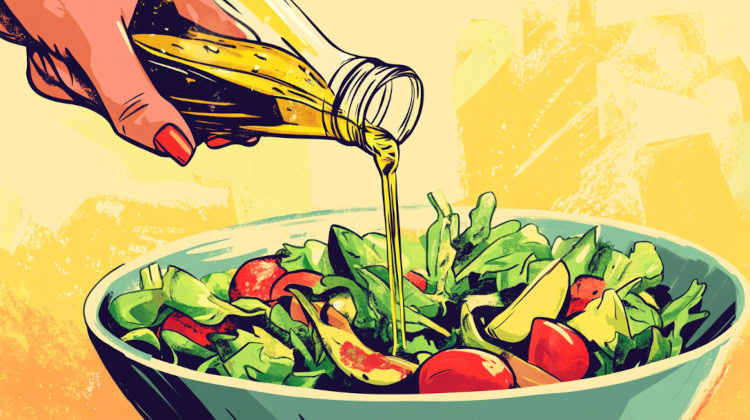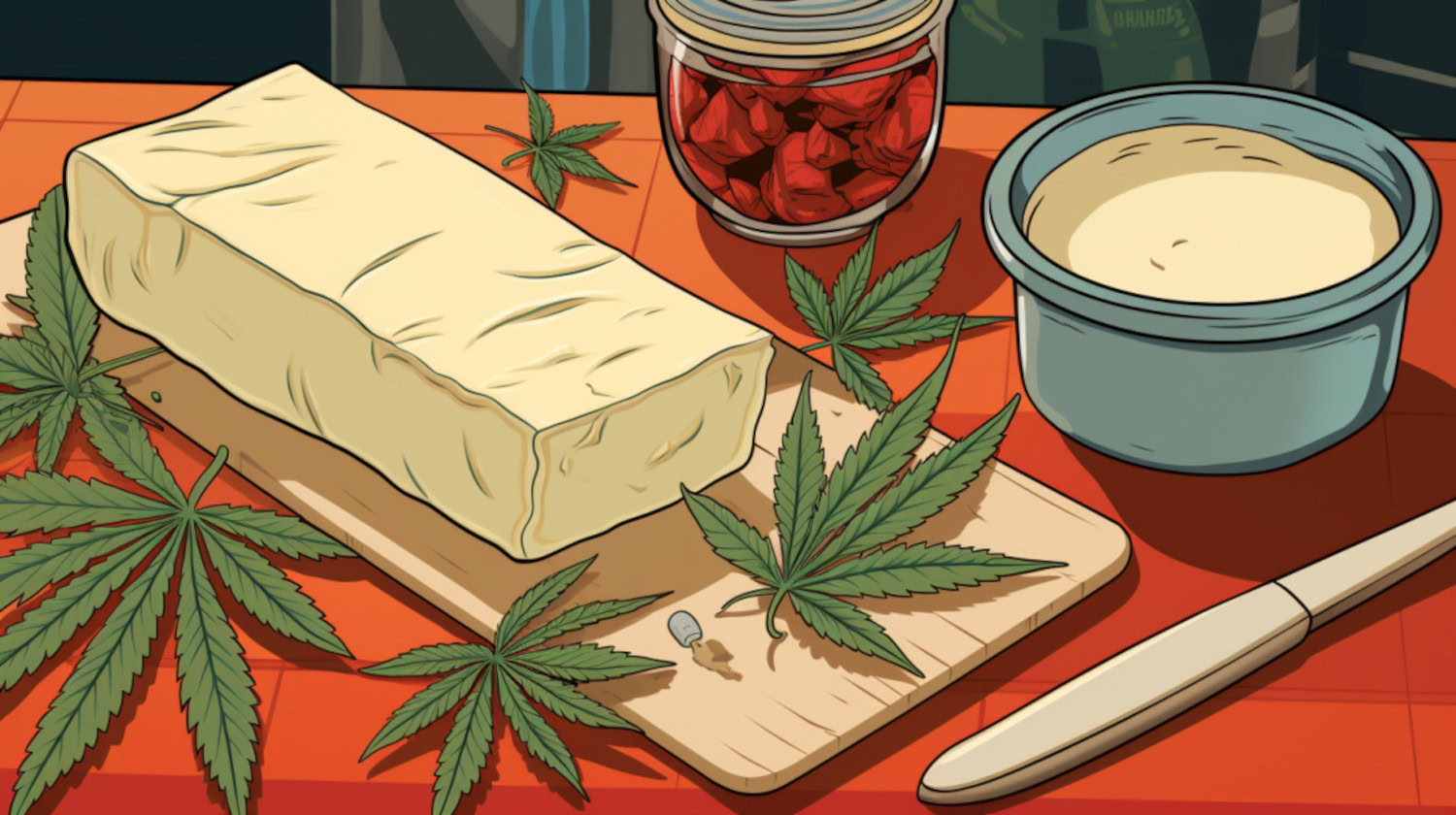In This Article
- Why Make Cannabis Infused Rosemary Oil?
- What You'll Need to Make Cannabis Infused Rosemary Oil
- How Much Weed Do You Need?
- Cannabis Infused Rosemary Oil: The Ingredients
- 1 Cup Olive Oil (Or Preferred Cooking Oil)
- 1/4 Cup Fresh Rosemary Leaves
- The Appropriate Amount of Flower or Extract for Your Dosing Plan
- Easy Dietary Swaps
- Vegan
- Gluten-free
- Kosher/Halal
- How to Make Cannabis-Infused Rosemary Oil
- The Best Way to Store Your Freshly Made Cannabis Infused Rosemary Oil
Key Takeaways
- Cannabis-infused rosemary oil is easy to make, requiring only a few ingredients.
- Cannabis extract or flower can be used.
- Decarb the flower > Heat oil with rosemary at 170F > Add decarbed weed and heat for 30 min > Cool and strain into a jar.
Infused oils have become a kitchen staple for home chefs looking to add depth and flavor to their cooking. Rosemary oil, in particular, is a popular choice thanks to its versatility, great taste, and pleasant aroma. Now, imagine elevating this kitchen favorite with cannabis, creating a unique infusion that not only enhances the flavor and aroma but also adds therapeutic benefits to many of its consumers.
Why Make Cannabis Infused Rosemary Oil?
Making cannabis-infused rosemary oil is a natural choice for anyone who enjoys the plant or this long-cherished kitchen essential. Known for its herbaceous flavor and aromatic qualities, rosemary oil is a staple across many of the world's kitchens. From roasted vegetables to various types of meat to numerous breads, rosemary oil adds depth and dimension to some of the world's favorite dishes and ingredients.
Adding cannabis to rosemary oil is a worthwhile endeavor for anyone who seeks to incorporate the plant into their daily routine without smoking or vaping. Additionally, infused oil allows cannabis consumers to enjoy the plant in its edible form without having to eat sugary, often gelatin-based gummies or chocolates that may disagree with a person's dietary preferences.
With infused rosemary, olive, or other popular oils, consumers can discreetly carry their cannabis or leave it out in the open (in child-free environments), taking it out to be added to meals or snacks as they please. Cannabinoid-infused oils can be especially beneficial for medical cannabis patients who want a discreet, smoke-free, potent way to experience cannabis' medicinal effects.
Outside its medicinal uses, cannabis-infused rosemary oil has several other benefits, including:
- Versatility: Rosemary oil adds flavor to just about anything. You can use it to finish salads, drizzle it over grilled vegetables, or base marinades and sauces.
- Discretion: Edibles like infused rosemary oils are perfect for those who prefer to keep their consumption discreet, providing big effects without standing out with a noticeable cloud or potent cannabis-heavy aroma.
- Health benefits: Rosemary is rich in antioxidants, and cannabis adds anti-inflammatory properties, making this infusion a health-conscious choice for many individuals looking to address certain ailments.
What You'll Need to Make Cannabis Infused Rosemary Oil

Creating cannabis-infused rosemary oil is straightforward, requiring a few must-have items. Before starting, ensure the following items are on hand:
- Small saucepan or double boiler: A double boiler helps control the heat during the infusion stage. This method maintains the oil and cannabis during infusion, as direct heat can degrade one or both elements.
- Mesh strainer or cheesecloth: Filtration will be needed to remove traces of rosemary leaves and cannabis flower from the final infused oil.
- Storage (Jar, bottle, etc.): Airtight containers help keep air and humidity away from the oil, extending its longevity. UV-protected containers are ideal, as light can degrade cannabis and food products over time.
- Cooking thermometer (optional): A thermometer ensures the oil doesn't overheat during infusion, preventing cannabis or oil from degrading due to excessive heat.
- Grinder (optional): Cannabis can be ground by hand or with DIY tools like scissors or grater cards, but a grinder provides a more even and efficient effort while keeping hands clean of sticky residue. If using cannabis extract, a grinder won't be necessary.
- Decarboxylation tools (flower infusion only): Flower infusion requires heating to convert THCA into THC through decarboxylation. This can be done using a decarboxylation tool or with an oven, a cookie sheet, and parchment paper.
How Much Weed Do You Need?
One of the most common questions to arise while learning how to make cannabis-infused oils is proper dosing. When answering how much cannabis should be used, the answer will depend on the desired potency and the tolerance of the consumer.
The flavor of the final product must also be considered. To help preserve rosemary's taste, a distillate or non-RSO cannabis extract may be the best choice. With flower, plant matter can often leave a heavy plant taste and aroma, which may adversely alter a robust, delicate aromatic profile like rosemary.
Beginners should be cautious with dosing, however. Working with extract may not be the most beginner-friendly method since the THC is usually fairly concentrated. If you plan on using flower, keeping it to 1g of flower or less per cup of oil is a fairly safe place to start.
For more experienced users considering those two significant points, determine which type of cannabis will be used. Then, gather the recommended amount:
- For cannabis extract: Depending on the strain and extraction method used, a gram of cannabis extract typically contains between 750mg and 1000mg of THC.
- For cannabis flower: Seven grams, or a quarter ounce, of decarboxylated cannabis flower, typically yields approximately 500mg and 700mg of THC if the strain used has a 15-20% THC potency. Depending on the strength desired, some recipes may call for ten or more grams of flower.
Adjust the amount used as desired. Also, consider using an edible calculator when infusing cannabis into the rosemary oil. An edible calculator lets you hone in on the specific amounts of cannabis, oil, and other ingredients needed for a delicious infusion with the right potency per serving.
Cannabis Infused Rosemary Oil: The Ingredients

With the proper kitchen and cannabis tools in place, it's time to focus on the ingredients. When making infused rosemary oil, be sure to have the following ingredients ready:
1 Cup Olive Oil (Or Preferred Cooking Oil)
Olive oil is versatile and healthy, making it an ideal base for many foodies and infused oil enthusiasts alike. Other oils, such as coconut and avocado, also work, possibly requiring minor recipe or infusion process adjustments.
1/4 Cup Fresh Rosemary Leaves
Fresh rosemary is recommended. Much like cannabis, fresh rosemary has a more intense aroma and flavor, making for a more robust consumption experience.
The Appropriate Amount of Flower or Extract for Your Dosing Plan
Infusers get to choose which path they'd prefer to work with. Unlike oil extraction, dabbing, or smoking, edibles aren't affected much by the cultivar selected, though some changes in effect may be noticeable. When making cannabis-infused rosemary oil, the cannabis can affect the flavor, especially when using aromatic strains. Many opt for flavorless distillates to preserve the rosemary's taste, though this sacrifices the complete plant profile.
Easy Dietary Swaps
Making cannabis-infused rosemary, olive, or other popular oils is a rather adaptive process, allowing for many dietary swaps if needed. However, most common dietary requirements are already met by the standard option.
Vegan
This is already a naturally vegan process. No changes are needed to meet this dietary requirement.
Gluten-free
Most oils, including pure rosemary, are naturally gluten-free. No changes are required to meet this dietary requirement.
Kosher/Halal
Religious interpretations of cannabis use may be more of a concern than the oil itself, as many rosemary oils meet kosher or halal rules. Still, consumers should ensure their oil and its ingredients meet kosher or halal standards before purchasing or consuming.
How to Make Cannabis-Infused Rosemary Oil
With the ingredients, essential tools, and cannabis oil recipe gathered, it's time to start making the infused rosemary oil.
- Prepare the Ingredients
Flower infusers need to grind and decarboxylate their buds as part of this step.
- Heat the Oil and Rosemary
Combine olive oil and rosemary leaves in a small saucepan or double boiler. Heat over low heat, stirring occasionally. Infuse for 20-30 minutes, maintaining a temperature of 160-180°F (70-80°C) to avoid any oil burning or degrading.
- Add the Cannabis
If using decarbed flower, add the converted bud to the rosemary-infused oil. Continue heating for 30-40 more minutes, stirring occasionally.
If using cannabis extract, add it to the rosemary oil after the infusion is complete to ensure the extract is evenly distributed throughout the oil.
- Strain the Oil
Remove the saucepan from the heat and allow the mixture to cool slightly. Then, strain through a mesh strainer or cheesecloth, collecting the oil in an airtight container. Before sealing, press the strained rosemary and cannabis to extract as much oil as possible.
- Use or Store for Later
Transfer the strained oil to a clean, airtight, and ideally UV-protected container. Use it right away or store it in a cool, dark place, such as a pantry or refrigerator, for later use.
Making infused oils is rather adaptable and easy, even suitable for most beginners. The process allows for ample customization along the way. Adjust the amounts of oil and cannabis used based on the desired amount of oil and THC dosage.
Once familiar with the basic recipe, feel free to experiment with different oils and herbs to replicate or create numerous cannabis oil recipes.
The Best Way to Store Your Freshly Made Cannabis Infused Rosemary Oil

Proper storage of cannabis-infused rosemary oil preserves its potency and flavor for the most prolonged period possible. Store in an airtight, UV-light-protected dark glass container placed in a cool, dark area to protect the oil from heat, air, and light. Refrigeration is recommended for the most extended shelf life, with infused rosemary oil usually remaining fresh for up to a month.
The information in this article and any included images or charts are for educational purposes only. This information is neither a substitute for, nor does it replace, professional legal advice or medical advice, diagnosis, or treatment. If you have any concerns or questions about laws, regulations, or your health, you should always consult with an attorney, physician or other licensed professional.




